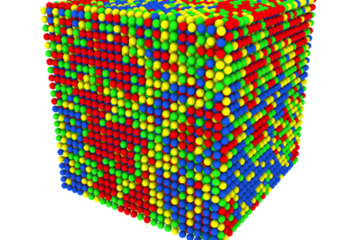All genres
1.
Journal Article
Advancing atom probe tomography capabilities to understand bone microstructures at near-atomic scale. Acta Biomaterialia 198, pp. 319 - 333 (2025)
2.
Journal Article
Long bone cortices in a growth series of Apatosaurus sp. (Dinosauria: Diplodocidae): Geometry, body mass, and crystallite orientation of giant animals. Biological Journal of the Linnean Society 112 (4), pp. 782 - 798 (2014)
3.
Journal Article
Structural and functional characterization of enamel pigmentation in shrews. Journal of Structural Biology 186 (1), pp. 38 - 48 (2014)
4.
Journal Article
Inner architecture of vertebral centra in terrestrial and aquatic mammals: A two-dimensionnal comparative study. Journal of Morphology 274 (5), pp. 570 - 584 (2013)
5.
Journal Article
Size and size distribution of apatite crystals in sauropod fossil bones. Palaeogeography, Palaeoclimatology, Palaeoecology 310, pp. 108 - 116 (2011)
6.
Journal Article
Synchrotron XRF Analyses of Element Distribution in Fossilized Sauropod Dinosaur Bones. Powder Diffration Journal 24, pp. 130 - 134 (2008)
7.
Book Chapter
Characterization of sauropod bone structure. In: Biology of the sauropod dinosaurs: understanding the life of giants, pp. 150 - 169 (Eds. Klein, N.; Remes, K.; Sander, P.M.). Indiana University Press, Bloomington and Indianapolis (2011)
8.
Talk
Atom Probe Tomography - a new approach to provide new insights into the interfacial reaction at the liquid-solid interface on the atomic scale. Institute Seminar FAU Erlangen-Nuremberg, Department of Materials Science, Erlangen-Nuremberg, Germany (2025)
9.
Talk
Atom probe tomography – a new technique to understand biominerals/materials on the atomic scale. 8th BioMAT 2025 - Symposium on Biomaterials and Related Areas, Weimar, Germany (2025)
10.
Talk
Early diagenesis in late Jurassic sauropod teeth revealed by transmission electron microscopy. Paleontological society of Southern Africa Biennial conference, Cape Town, South Africa (2012)
11.
Talk
Crystallographic investigations of a growth series of Apatosaurus long bones: Are sauropods bone highly adapted for strength? Second Internation workshop on Sauropod Gigantism, Bonn, Germany (2011)
12.
Talk
Crystallographic investigations of a growth series of Apatosaurus long bones: Implications for biomechanics. 71st SVP meeting, Las Vegas, NV, USA (2011)
13.
Talk
Texture and nanostructure of Sauropod bones: Implications for biomechanics. 1st International symposium on paleohistology, Barcelona, Spain (2011)
14.
Talk
Comparison of apatite crystallite sizes in sauropod and mammal fossil bones. 6th Bone diagenesis meeting, Poppelsdorfer Schloss, University of Bonn, Germany (2009)
15.
Talk
Synchrotron XRF analyses of element distribution in fossilized sauropod dinosaur bones. Denver X-ray Conference, Denver (2008)
16.
Talk
Trabecular architecture of vertebral centra in pelagic tetrapods. 8th Meeting Sauropod Biology, München, Germany (2007)
17.
Poster
Comparison of apatite crystallite sizes in sauropod and mammal fossil bones. 6th Bone diagenesis meeting, Poppelsdorfer Schloss, University of Bonn, Bonn, Deutschland (2009)
18.
Poster
Hierarchical structure of Sauropod long bones. 9th Meeting of the Research Unit 533, Biology of the Sauropod Dinosaurs: The Evolution of Gigantism, Bonn, Germany (2008)











